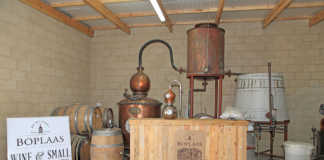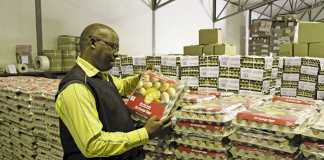
Photo: FW Archive
Once a year, farmers spend a great deal of time and energy selecting seed for the upcoming season. No producer can realise a good harvest from poor-quality seed, even if he or she has access to the finest equipment and technology.
Countless farmers have fallen into the trap of buying cheap, uncertified, untested seed, sometimes packaged in unlabelled bags. In addition to the risk of poor germination and low yield, these seed containers could contain unwanted weed seeds, which may end up contaminating an entire land, farm or even district.
Farmers face numerous production obstacles, and starting each planting season with good seed can counter many of these challenges. Using high-quality seed will help to ensure the establishment of strong seedlings and the best chance of reaching a variety’s full potential.
Seed determines yield potential, and although the environment will obviously have an influence, the cultivar’s genetics form the basis for yield potential.
Variables such as soil quality or pests and diseases can be managed to a certain extent; other factors, like the weather, lie beyond a farmer’s control. Farmers do, however, have control over their seed choices. The yield potential of a variety or hybrid, regardless of environmental conditions or cultivation practices, is dependent on the chosen variety’s characteristics and adaptability to the environment.
Varietal purity
Another crucial element that plays a role in yield realisation is varietal purity. This is the extent to which each plant complies with the varietal characteristics as developed by the breeder.
By using seed of the best available quality and highest genetic potential, farmers achieve two key aims: they eliminate a potential source of crop failure, and increase the likelihood of reaping a profitable harvest. Farmers are thus able to buy peace of mind by investing in good-quality, certified seed.
According to Kobus van Huyssteen, acting technical manager at the South African National Seed Organization (SANSOR), seed quality has a number of measurable components:
- Purity: this includes the genetic (varietal) quality and physical characteristics (presence or absence of foreign material);
- Health: symptoms and effects of pathogens;
- Physical traits: deviation from uniform size, and damaged seed; and
- Biological traits: germination, vigour, and seed moisture.
Van Huyssteen urges farmers to make sure they buy seed from reputable seed companies, SANSOR members or distributors.
“Farmers should pay attention to the seed label on the seed bag or container. Understanding the label will allow for proper decision-making when it comes to seed purchases and planting.”
Distinctive blue label
The basic labelling information is prescribed by the Plant Improvement Act (No. 53 of 1976) and must be printed on the company label. If the seed lot is certified, the additional information, as required by the South African Seed Certification Scheme, must be printed on the certification label supplied by SANSOR.
The distinctive blue seal, blue label and accompanying certificate serve as proof that a specific seed lot has been certified in terms of the scheme.
“A blue certification label on a seed bag is testimony to the fact that the specific seed lot has been certified and thus complies with standards set by government and the industry, and that it contains the characteristics that were promised.
“Simply put, certification means that a bag, packet, tin or box of seed contains what is stated on the label and that it meets the acceptable standards of seed viability/germination, physical purity, and the varietal purity and varietal identity of the seed,” says Van Huyssteen.
He adds that the seed label will help ensure that the farmer buys the correct species or variety. In addition, the label provides information on the weight and/or number of seeds in the bag, germination percentage, and the month and year in which the seed container was sealed (in the case of certain international certification schemes).
No company may use the words ‘certified’ or any other term that would suggest that a seed lot has been certified unless the seed has been certified in terms of a recognised seed certification scheme and documentary evidence thereof is available.
Seed certification is an internationally recognised system to maintain the genetic identity and purity of varieties. In the early days of crop improvement, most varieties had easily identifiable
and visible traits. Today, this is not so easy, and certification is one way of ensuring varietal purity.
Hybrid seed and other bred varieties are the result of many years of research and development, including the incorporation of improved traits, such as herbicide tolerance and resistance to pests or diseases. Thus, seed certification through field inspections and laboratory tests, along with continual updating of pedigree records, provide the most practical and reliable method of verifying genetic identity and purity for the improved varieties commercially available.
Each container of certified seed must be identified with a label provided by SANSOR, and only these may be used. Labels and seals are identified with a unique serial number, and different labels are provided for seed certified under the various recognised schemes. There are also labelling requirements for unprocessed seed, and some requirements and dispensations for the required information on small packs.
Seed companies are also required to keep complete records on the use of every certification label received from SANSOR.
“For certification purposes, the labels must be fixed to seed containers in such a manner that the information can be read easily. The wording must be legible and the ink colour-fast, and the information must be printed,” says Van Huyssteen.
REQUIRED LABELLING
The Plant Improvement Act regulations require that the following particulars be indicated on a container or label attached to a container:
- The common or botanical name of the kind of plant to which the seed belongs;
- The denomination of the variety of the seed;
- The lot number of the seed;
- The words ‘percentage germination’ or ‘percentage viability’, followed by the group in which the actual percentage germination or viability of the seed falls, expressed within a range, such as ‘80 – 89’, for example;
- In the case of Chloris gayana, for instance, where germination is alternatively determined by the replicate weight method, germination shall be expressed as the number of normal seedlings per weight;
- The name and address of the establishment where the seed is sold or resold, and the name and address of the establishment from which it was obtained may also be indicated;
- The words ‘percentage pure seed’ or ‘persentasie suiwer saad’, followed by the actual percentage pure seed in such seed if the container has 97% or less pure seed; and
- The word ‘hybrid’ or ‘baster’ may also be indicated on the container or label if the seed consists of at least 90% hybrid seed of a variety.
The wording on the container in which the seed is sold or on a label attached to a container must comply with the requirements concerning seed that has been treated with a poisonous substance, as prescribed in terms of the Fertilizers, Farm Feeds, Seeds and Remedies Act (No. 36 of 1947), the Medicines and Related Substances Act (No. 101 of 1965), the Foodstuffs, Cosmetics and Disinfectants Act (No. 54 of 1972), and the Hazardous Substances Act (No. 15 of 1973).
SANSOR has published an industry guideline for the labelling of treated seed that does not replace the requirements set out in any Act, but is merely complementary.
Visit SANSOR.













